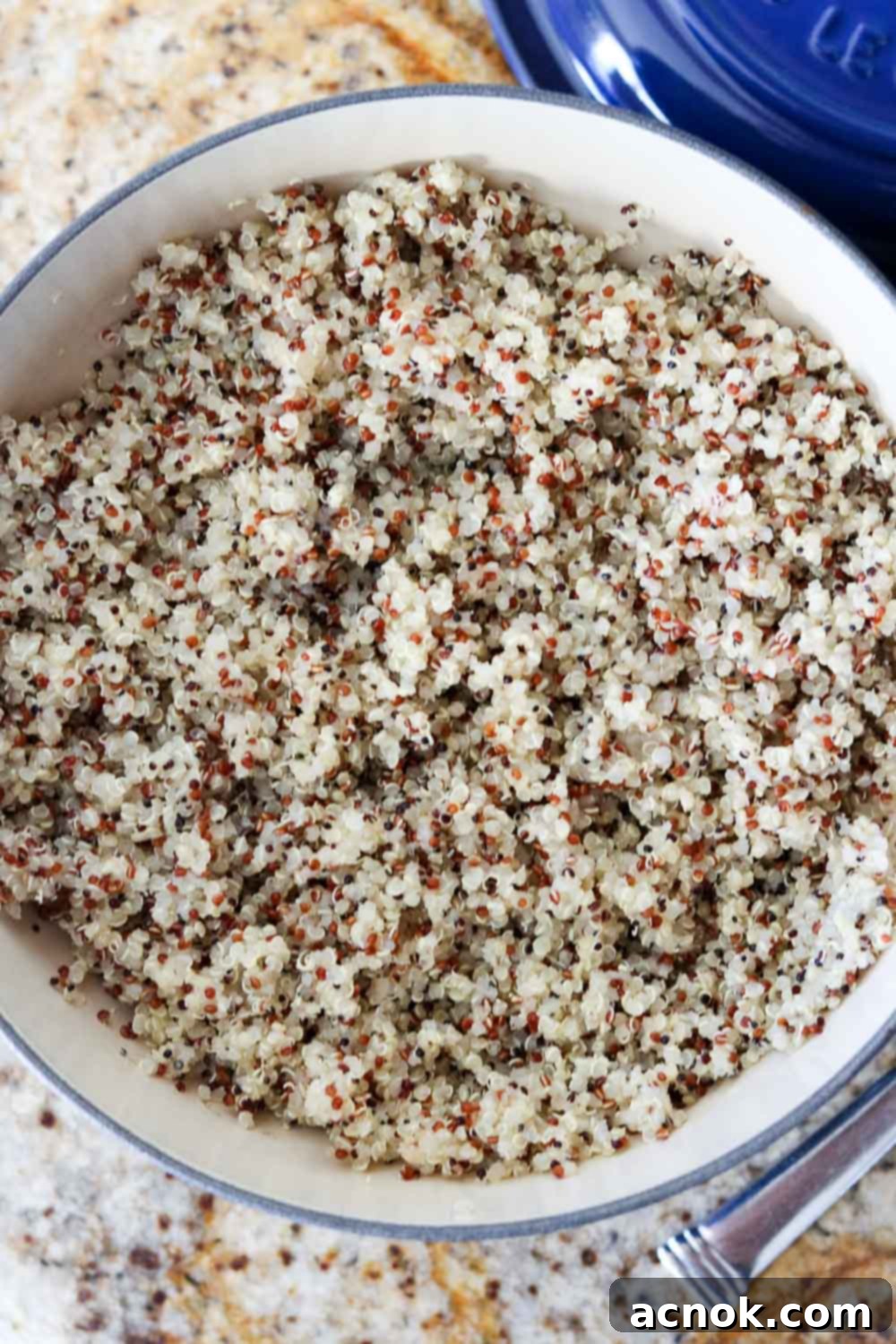How to Cook Perfect Quinoa Every Time: Your Ultimate Stovetop Guide
For many home cooks, the mere mention of quinoa can conjure images of a frustrating, mushy, or inconsistent grain. My own sister, for instance, used to dismiss it with a simple “whatever” because of its perceived fussiness in the kitchen. And honestly, I can relate! In my early days of cooking, quinoa often turned out less than ideal, a stark contrast to the fluffy, separate grains I craved. Like many, I initially assumed I could cook it just like rice, only to be met with disappointment. But here’s a secret: achieving perfectly cooked quinoa is surprisingly simple once you understand a few key principles. It’s not about complex techniques, but rather precise steps and a little patience. Through trial and error, I’ve discovered a foolproof stovetop method that consistently yields light, fluffy, and delicious quinoa, transforming this versatile pseudograin from a culinary challenge into a kitchen staple. Today, I’m excited to share this tried-and-true approach, ensuring you can enjoy perfect quinoa every single time.
This ancient “superfood” is a powerhouse of nutrition and incredibly versatile, making it a valuable addition to any diet. Whether you’re a seasoned cook looking to refine your technique or a beginner hoping to conquer this often-misunderstood grain, this comprehensive guide will walk you through my best method. Get ready to unlock the full potential of quinoa and incorporate it seamlessly into your daily meals, from vibrant salads to hearty side dishes, proving that perfectly cooked quinoa is well within reach for everyone.
What Exactly is Quinoa? Unpacking This Ancient Superfood
Quinoa, pronounced KEEN-WAH, is more than just a trendy health food; it’s an ancient grain (technically a pseudocereal, as it’s a seed from a broadleaf plant) that originated in the Andean regions of South America thousands of years ago. Revered by the Incas as the “mother of all grains,” it has sustained civilizations for centuries, valued for its incredible nutritional profile and resilience in harsh climates. Today, its popularity has surged globally as more people discover its remarkable health benefits and culinary versatility.
A Nutritional Powerhouse: The Incredible Benefits of Quinoa
What truly elevates quinoa to the status of a superfood? Let’s delve into the impressive array of nutrients packed into this small, humble seed. Quinoa is exceptionally rich in essential vitamins and minerals, playing a vital role in various bodily functions. It’s an excellent source of Manganese, crucial for bone health and metabolism; Magnesium, vital for muscle and nerve function; Phosphorus, important for cell repair; Folate, essential for cell growth; Copper, Iron, Zinc, Thiamin (Vitamin B1), Riboflavin (Vitamin B2), and Vitamin B6, all contributing to overall well-being. Beyond these micronutrients, it offers substantial macronutrient benefits. A single cup of cooked quinoa (approximately 185 grams) contains around 220 calories, alongside a remarkable 8 grams of high-quality protein, 4 grams of healthy fats (including beneficial omega-3 fatty acids), and 5 grams of dietary fiber. This potent combination supports everything from digestive health to sustained energy levels, making it an ideal food for active lifestyles.
Perhaps one of quinoa’s most celebrated attributes, especially for those following plant-based diets, is its status as a complete protein. Unlike most plant-based proteins, which often lack one or more essential amino acids, quinoa provides all nine essential amino acids that the human body cannot produce on its own. These building blocks of protein are crucial for muscle repair, immune function, hormone production, and overall bodily health. This makes it an invaluable food source for vegetarians, vegans, and anyone looking to diversify their protein intake without relying solely on animal products, cementing its place as a nutritional superstar.
Exploring the Different Types of Quinoa
When you head to the grocery store, you’ll typically find a few varieties of quinoa readily available, primarily white, red, and black, or a convenient tri-color mix. While their nutritional profiles are largely similar, there are subtle differences in texture, flavor, and cooking characteristics that can influence your choice for different dishes:
- White Quinoa: This is the most common variety and often considered the “original” quinoa. It has the mildest flavor and cooks up the fluffiest, with a delicate, soft texture. It’s perfect for recipes where you want quinoa to blend in seamlessly without overpowering other flavors, such as a light side dish, breakfast bowls, or when used as a base for sauces. Its quick cooking time also makes it a popular choice.
- Red Quinoa: Offering a slightly nuttier, more intense, and earthy flavor than white quinoa, red quinoa also tends to hold its shape better after cooking, making it an excellent choice for cold salads where you want distinct grains that don’t clump together. Its firmer, chewier texture provides a satisfying bite, and its vibrant reddish-brown color adds visual appeal and a rustic touch to your dishes. It’s also great in grain bowls or as a more robust side.
- Black Quinoa: This variety boasts the deepest, most earthy flavor profile among the three. It’s the chewiest and retains its firm structure even after being fully cooked, sometimes taking a minute or two longer to become tender. Black quinoa is fantastic in heartier dishes, such as substantial grain bowls, as a base for roasted vegetables, or wherever you desire a pronounced texture and flavor contrast. Its striking dark color adds a sophisticated look to any plate.
- Tri-Color Quinoa: As the name suggests, this is a blend of white, red, and black quinoa. It combines the best attributes of all three: the fluffiness of white, the slightly chewy texture of red, and the earthy notes of black. I often find myself gravitating towards the tri-color mix for its beautiful presentation and its ability to hold up exceptionally well in a wide variety of dishes, especially those with other ingredients like stir-fries, warm pilafs, or roasted vegetable medleys, offering a balanced taste and texture experience.
Mastering the Art of Perfect Quinoa: My Foolproof Stovetop Method
Achieving perfectly fluffy, distinct quinoa grains isn’t complicated, but it does require attention to a few crucial details. Forget the mushy or bitter results of the past – follow these steps, and you’ll be cooking like a pro in no time, ensuring a consistently excellent outcome.
Essential Tips for Fluffy Quinoa Every Time
- Rinse Thoroughly (and I Mean Thoroughly!): This is perhaps the most critical step that many people overlook, leading to a common complaint of bitter-tasting quinoa. Quinoa seeds are naturally coated with saponin, a bitter, soap-like compound that serves as a natural pest repellent. To remove it, place your measured quinoa in a fine-mesh strainer and rinse it under cold running water for at least a full minute. You’ll notice the water initially appears cloudy and foamy. Continue rinsing and tossing the grains until the water runs completely clear. This step is absolutely non-negotiable for delicious, mild-flavored quinoa!
- Perfect Water-to-Quinoa Ratio: The ideal and consistently reliable ratio is 1 part dry quinoa to 2 parts liquid. For example, if you’re cooking 1 cup of dry quinoa, you’ll need 2 cups of water or broth. This precise ratio is key to preventing both mushy (too much liquid) and undercooked (too little liquid) grains. Using vegetable or chicken broth instead of plain water can add a wonderful depth of savory flavor to your quinoa, making it even more delicious as a side dish or base for other meals.
- Start Cold, Boil, Then Simmer: Unlike rice, where you might add it to already boiling water, quinoa cooks best when it heats up along with the liquid. This allows the grains to absorb the water more evenly and gently expand as the temperature slowly rises, leading to a more consistent texture.
- Use a Pot with a Tight-Fitting Lid: A snugly fitting lid is absolutely essential for trapping steam and ensuring even cooking. Steam is what truly cooks quinoa to perfection, helping it expand and become light and fluffy. Avoid the temptation to lift the lid during the simmering process, as this releases valuable steam and heat, which can disrupt cooking.
- The All-Important Resting Period: Once the cooking time is up and the heat is off, resist the urge to immediately open the lid. Allowing the quinoa to rest, still covered, for a few minutes (typically 5-10) enables it to absorb any remaining moisture and steam, resulting in a drier, fluffier texture where each grain is distinct and plump. This step is often overlooked but makes a significant difference.
- Fluff with a Fork: After the resting period, use a fork (not a spoon) to gently fluff the cooked quinoa. This action separates the grains, prevents clumping, and releases any trapped steam, ensuring a light and airy consistency that’s perfect for incorporating into salads, grain bowls, or serving as an elegant side dish.
Step-by-Step Stovetop Quinoa Recipe for Beginners
Ready to cook? Here’s my easy-to-follow, go-to method for perfectly fluffy quinoa, designed to deliver consistent results every single time:
- Rinse Quinoa: Place 1 cup of dry quinoa in a fine-mesh sieve and rinse thoroughly under cold running water for 1-2 minutes until the water runs completely clear. This step removes saponin and ensures a mild, pleasant taste. Drain well.
- Combine Ingredients: Transfer the rinsed, drained quinoa to a medium saucepan with a tight-fitting lid. Add 2 cups of water (or your preferred broth for enhanced flavor) and a pinch of salt if desired.
- Bring to a Boil: Place the saucepan over medium-high heat and bring the mixture to a rolling boil.
- Simmer: Once boiling, immediately reduce the heat to the lowest setting possible, cover the pot tightly with its lid, and let it simmer undisturbed for 15 minutes. It’s crucial not to lift the lid during this time, as the steam is doing all the work.
- Rest: After 15 minutes, remove the pot completely from the heat source (keeping it covered) and let it rest for another 5-10 minutes. This allows the quinoa to fully absorb any remaining liquid and steam, leading to perfectly tender and distinct grains.
- Fluff and Serve: Finally, remove the lid and gently fluff the cooked quinoa with a fork. Serve immediately as a healthy side, or allow it to cool completely before using in salads or for meal prep.
Troubleshooting Common Quinoa Mistakes
Even with the best instructions, sometimes things go awry. Here’s how to address common issues and ensure your quinoa turns out perfectly every time:
- Mushy Quinoa: This usually means too much water or overcooking. Double-check your 1:2 quinoa-to-liquid ratio precisely. Ensure you reduce the heat immediately after boiling to a low simmer. The resting period is also crucial for absorbing excess moisture, so don’t skip it!
- Hard or Crunchy Quinoa: This is a sign of too little water or not enough cooking time. Reconfirm your water ratio. If your quinoa is still hard after the initial cook and rest, you can add a tablespoon or two of hot water, re-cover the pot tightly, and let it steam for another 5 minutes on very low heat.
- Bitter Taste: Almost always due to insufficient rinsing. Make sure you rinse the quinoa under cold running water until the water is completely clear, for at least 60 seconds.
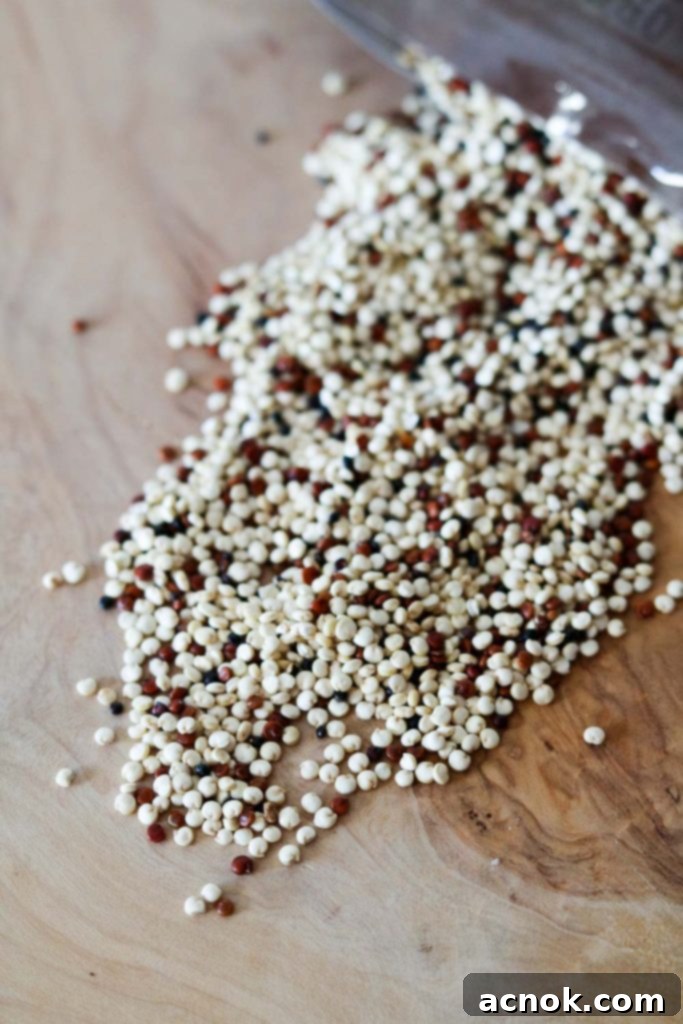
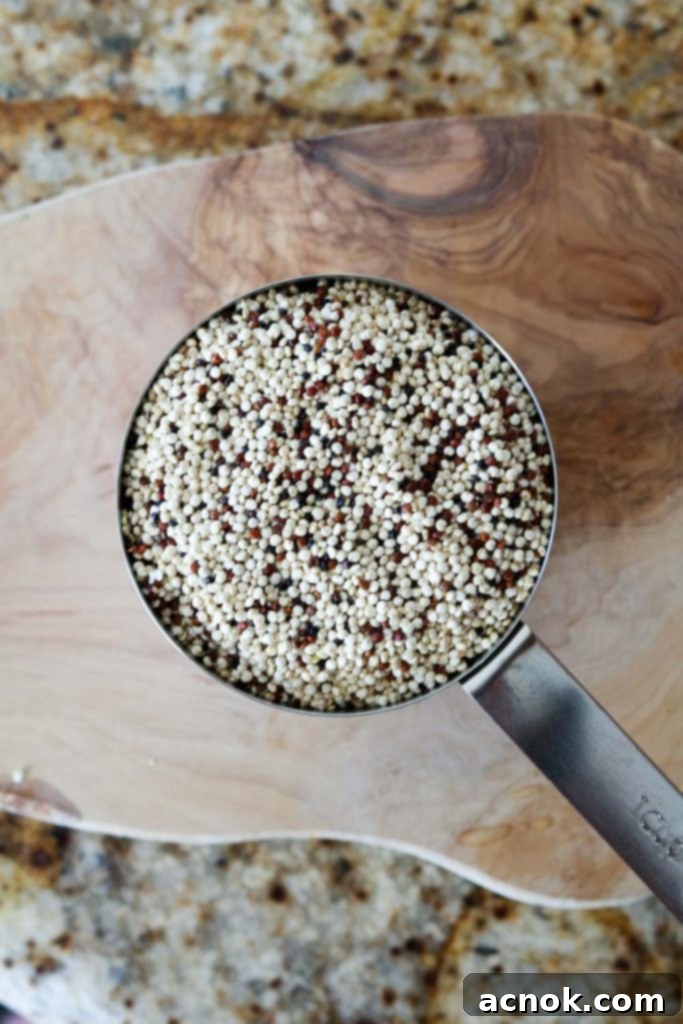
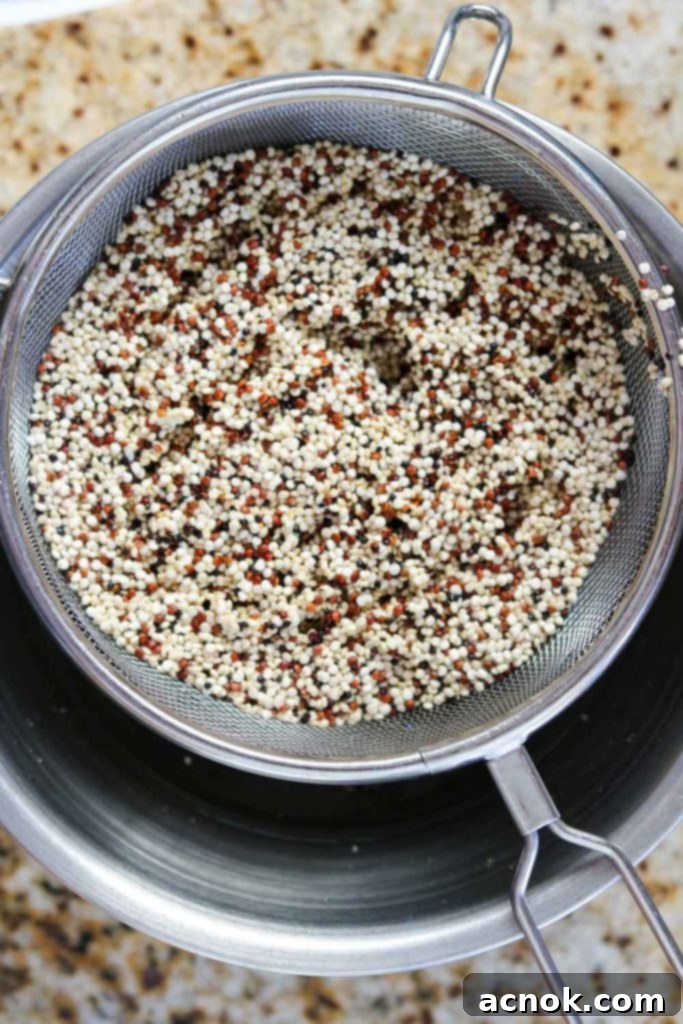
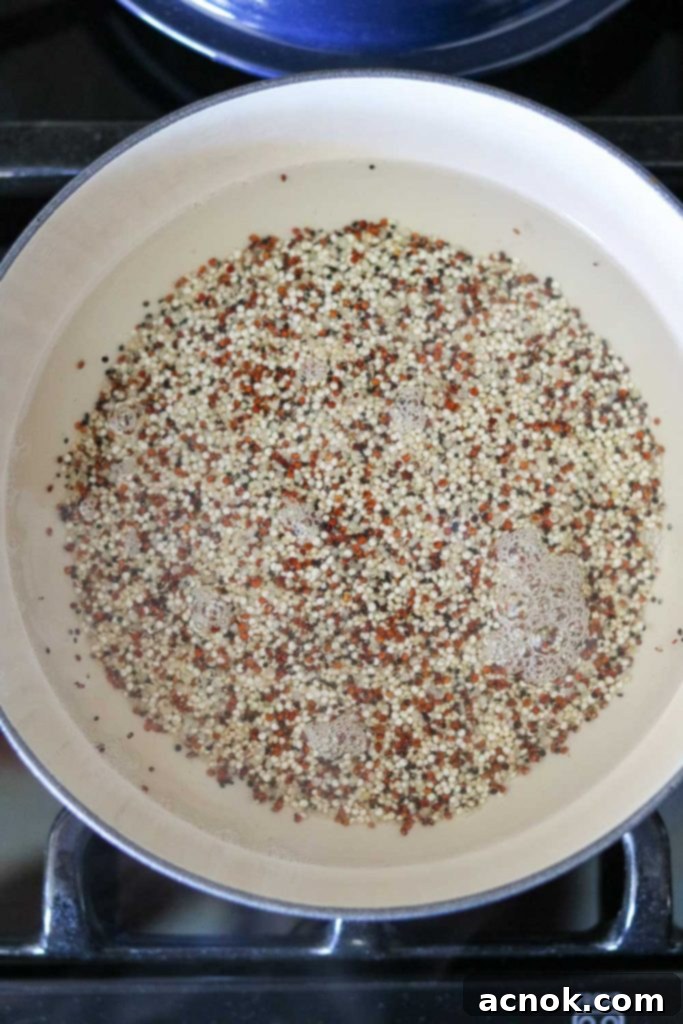
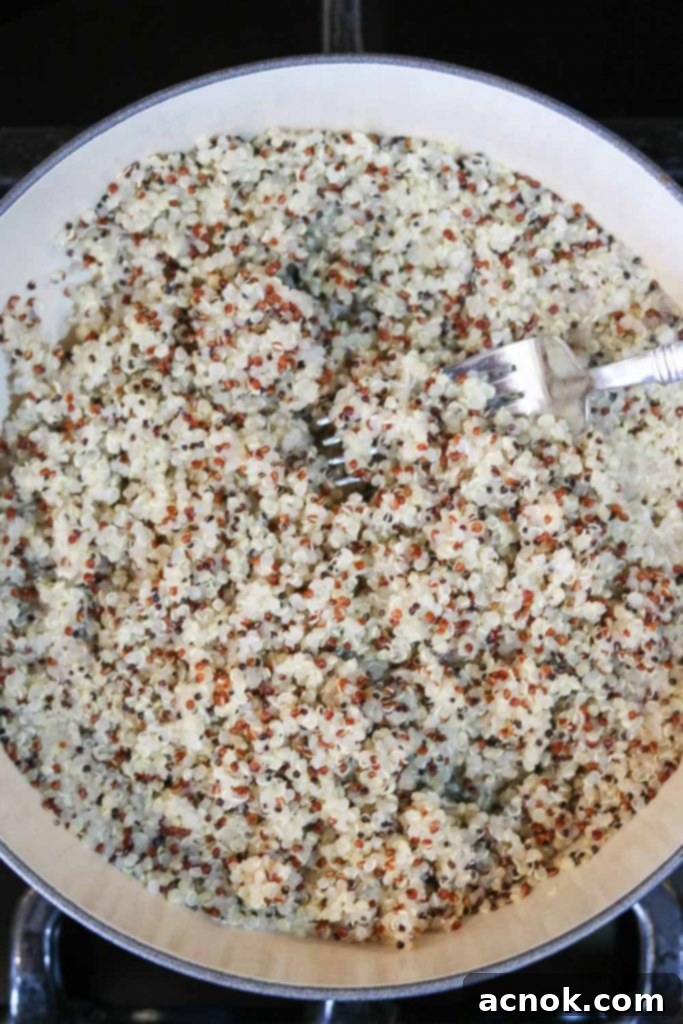
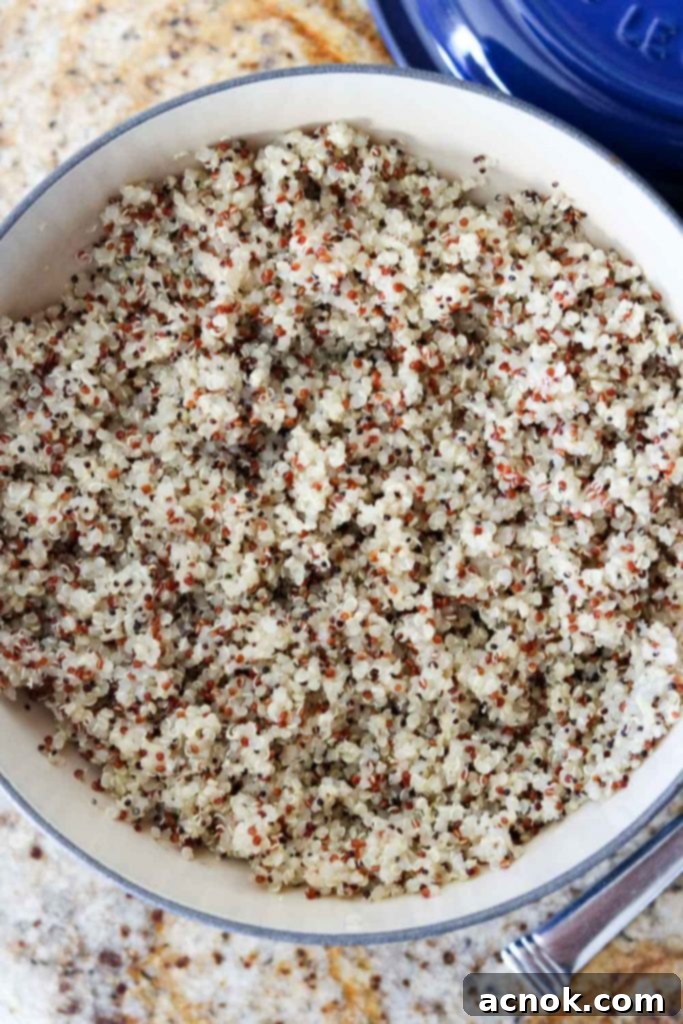
Why Quinoa Deserves a Permanent Spot in Your Pantry
Beyond its impressive nutritional profile and ease of cooking, quinoa truly shines in its incredible versatility. Once you’ve mastered the simple technique of cooking it, you’ll find countless ways to incorporate this superfood into nearly every meal of the day, making it an indispensable pantry staple for healthy, delicious, and convenient eating. Its ability to absorb flavors and its pleasing texture make it a fantastic base or addition to a vast array of dishes.
Creative Ways to Enjoy Your Perfectly Cooked Quinoa
Don’t limit quinoa to just a side dish! Here are some inspiring ideas to weave this nutritious grain into your daily diet:
- Breakfast: Transform it into a hearty and warming breakfast bowl. Serve it warm with fresh berries, sliced banana, crunchy nuts, a drizzle of honey or maple syrup, and a splash of your favorite milk (dairy or plant-based). It’s a wonderful, protein-packed alternative to traditional oatmeal.
- Lunch: Cold quinoa makes an excellent base for vibrant, filling, and portable salads. Combine it with roasted vegetables, fresh leafy greens, chickpeas, crumbled feta or goat cheese, and a light, zesty vinaigrette for a perfect midday meal. It’s also fantastic for meal prepping for the week ahead, as it holds up well.
- Dinner: Serve it as a healthy and flavorful side dish to grilled chicken, baked fish, roasted tofu, or any main course. Use it as a protein-rich stuffing for bell peppers, zucchini, or even mushrooms. Incorporate it into homemade veggie burgers or meatballs for added texture and nutritional value. It can also be the star of a one-bowl meal with various roasted vegetables and a flavorful sauce, such as tahini or pesto.
- Soups and Stews: Add cooked quinoa to your favorite soups, stews, or chili in the last few minutes of cooking. It will absorb some of the broth, adding extra body, fiber, and a significant protein boost to your comforting dishes.
- Baking: Believe it or not, cooked quinoa can even be added to baked goods like muffins, energy bars, or bread for a nutritional boost, added moisture, and an interesting, slightly chewy texture.
Storing Cooked Quinoa for Easy Meal Prep
One of the best aspects of quinoa is how well it stores, making it a dream for meal prepping. Once cooked and fluffed, allow it to cool completely to room temperature before transferring it to an airtight container. It can be stored safely in the refrigerator for up to 5-7 days, making it incredibly convenient for quick, healthy meals throughout your busy week. For longer storage, you can also freeze cooked quinoa: spread it out in a single layer on a baking sheet to freeze individually (this prevents clumping), then transfer the frozen grains to a freezer-safe bag or container. It will keep well in the freezer for up to 2-3 months. Thaw it in the refrigerator overnight or reheat directly from frozen, adding a splash of water if needed to rehydrate.
Delicious Quinoa Recipes to Inspire Your Next Meal
Now that you’re a quinoa cooking pro, armed with the knowledge to create perfectly fluffy grains every time, it’s time to put your skills to good use! Here are some of my favorite recipes that beautifully highlight the versatility and deliciousness of perfectly cooked quinoa, ready to become staples in your kitchen:
- For a warm, hearty, and incredibly flavorful meal, be sure to try my Pan Roasted Vegetable Quinoa with Feta. It’s packed with vibrant ingredients and savory notes that are sure to satisfy.
- Another excellent option that pairs beautifully with seasonal produce is Warm Quinoa with Roasted Asparagus and Peppers, perfect as a comforting side or a light, nutritious main course.
- If you prefer a refreshing cold dish that’s bursting with freshness, my Colorful Superfood Spinach Salad is a fantastic way to enjoy quinoa in a vibrant, healthy, and incredibly satisfying salad.
With this ultimate stovetop guide in hand, you are now fully equipped to cook perfect, fluffy, and delicious quinoa every single time. Say goodbye to mushy grains, bitter tastes, or inconsistent results, and hello to a nutritious, versatile, and incredibly satisfying superfood that will elevate your meals and fuel your body. Happy cooking, and enjoy the many benefits of mastering this ancient grain!
